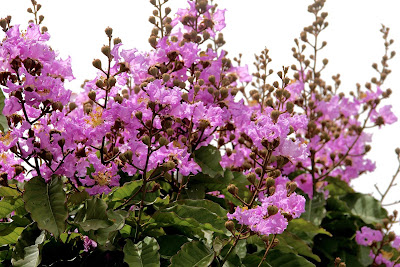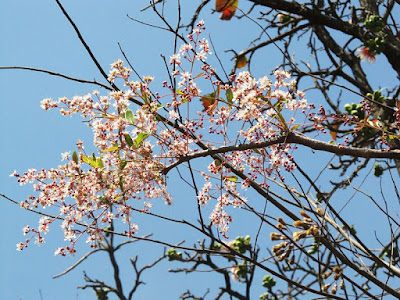LAGERSTROEMIA 'SAVNI'- QUEEN's FLOWER (TREE AND SHRUB)
LAGERSTROEMIA 'SAVNI'- QUEEN's FLOWER (TREE AND SHRUB)
 |
| LAGERSTROEMIA (SAVNI) |
LAGERSTROEMIA (TREE)
Lagerstroemia is named after Magnus Von Lagerstrom, a Swedish patron of science. A genus of 25 speciesof trees and shrubs of Asia, Africa and Australia.
Lagerstroemia is named after Magnus Von Lagerstrom, a Swedish patron of science. A genus of 25 speciesof trees and shrubs of Asia, Africa and Australia.
Lagerstroemia parviflora
Native of western Himalaya, South India and the Gangetic plains of India.
Description: A tall tree, attaining a height of 20 m. Leaves oblong, acute or acuminate, prominently reticulate, 5-8 cm long. Flower white, or many-flowered axillary and terminal panicles; petals 1.5 cm long. Fruit a capsule, variable in size, 2-2.5 cm long, with many winged seeds.
Gardening: A fairly quickly-growing tree, suitable for planting along avenues and in large gardens. It grows well both in dry and humid climate; flowers appear profusely during the summer months but finish earlier than L. speciosa. Usaually propagated from seeds.
 |
| LAGERSTROEMIA PARVIFLORA |
Lagerstroemia speciosa (syn. L. flos-reginae)
(Giant crape myrtle, Pride of India, Queen's flower)
In Latin speciosa means 'beautiful' and flos-reginae meaning 'queen's flower'. Common in East and South India; wild in the forests of Burma and Sri Lanka, particularly in the moist localities, swampy lands and on river banks.
Description: A very showy, large, deciduous tress with globular crown, reaching 15-20 m height; trunk short, both trunk and limbs have smooth, greyish cream-coloured bark which peels off in irregular flakes during increase in girth.
Leaves from elliptic to lanceolate, mostly opposite on short, stout stalks, glabrous, bright green above and lighter below, 15-30 cm long and 6-9 cm wide.
Flowers wide open, 5-7 cm across on large panicles 30-45 cm long at the tip of branches; petals mostly long and 6-9 cm wide. Flowers wide open, 5-7 cm across on large panicles 30-35cm long at the tip of branches; petals mostly 6, about 3cm long, clawed, rounded and crumpled, spreading, mauve in colour.
Fruit a capsule, elliptic or spherical, 2-2.5 cm, woody; seed light brown, angular, about 1 cm.In this species, a type is also seen with larger leaves, longer spike and larger flowers, often termed as L. speciosa 'Magnifica'.
Gardening: Prefers warm, humid climate and moist, deep soil. It can stand waterlogging very well; survive submergence for several days. Propagated by seed, growth in the first year is slow, but faster afterwards. Flowering starts in 4-6 years.
Training is needed to build a clean stem. Leaves fall off in winters; new shoots emerge in spring along with terminal inflorescence. The main flowering period is from April to June; occassionally a second flush appears, specially in young plants.
Very good for roadside, canal side, group planting, planting alon a large lawn, or around water gardens and ponds.
 |
| LAGERSTROEMIA SPECIOSA |
Lagerstroemia speciosa 'Rosea'
Description: It is almost as beautiful as L. speciosa with some difference.
A dwarf and bushy tree, 6-8 m high. Leaves elliptic, obtuse, about 10 com long and 5 cm wide. Flowers nearly 3 cm across, in large, terminal panicles 30-40 cm long; mauve, fading to almost white, thus giving a bicolour effect. Fruit ovoid, 2 cm long; seeds about 1 cm long, winged.
Gardening: The tree starts flowering from June and continues up to September or beyond. Leaves fall during winter, reddish new leaves appear in spring.
This plant has the same ornamental use as L. speciosa, but can be used in smaller space where the former cannot be accommodated.
It is one of the most attractive flowering trees and often planted on roadside and in small and large gardens. Propagated from seeds; plants start flowering in 4-5 years.
LAGERSTROEMIA (SHRUBS)
In this genus L. indica is widely grown as shrub, probably a native to China.
Lagerstroemia indica
(Crape myrtle)
Description: A much-branched, woody, erect, large shrub up to a height of 4 m; shoots angular, brownish, glabrous. Leaves alternate or in a whorls of three, obovate, 3.5-6.0 cm long, glabrous.
Flowers arise in large terminal panicles, 15-20 cm long; petals 6; with a slender claw and much crinkled limb, 3 cm across.
Colour white, rose, pink, mauve and also shades of pink and mauve.
indica 'Aliporensi' : Flowers light mauve.
indica 'Candida' : Flowers white.
indica 'Rosea' : Flowers rose.
Varieties with mauve and pink flowers are grown in gardens.
Flowers arise in large terminal panicles, 15-20 cm long; petals 6; with a slender claw and much crinkled limb, 3 cm across.
Colour white, rose, pink, mauve and also shades of pink and mauve.
indica 'Aliporensi' : Flowers light mauve.
Varieties with mauve and pink flowers are grown in gardens.
Gardening: A hardy, deciduous shrub, grows in to a small tree, if left unpruned. Pruning in February will result in the formation of straight long shoots which will bear large inflorescence from May to August.
 |
| LAGERSTROEMIA INDICA |
Lagerstroemia lancasteri
Description: A hybrid, origin not known. Large, woody shrub, up to 3 m; stem light brown, with scaly bark, shoots angular when young. Leaves opposite or irregular, oblong 7-12 cm long, 3.5-6.5 cm broad, glossy green above, pale beneath.
Flowers large on terminal panicle, 18-25 cm long; petals 6, mauve in color, fringed with a slender claw, about 5.0 cm across.
Gardening: Pruning should be done in February to a height of 45 to 60 cm and new shoots will bear long panicle of large mauve flowers from may till August. The leaves and flowers are bigger than those of L. indica. Plants are generally propagated through cuttings.
YOU'LL ALSO LOVE READING:
Subscribe us.
Visit our Social handles to know more.
instagram: www.instagram.com/bholanursery
facebook: www.fb.com/bholanursery
youtube: www.youtube.com/bholanursery
website: https://www.bholanursery.com
LAGERSTROEMIA 'SAVNI'- QUEEN's FLOWER (TREE AND SHRUB)
 Reviewed by Vishal Lodhi
on
April 17, 2020
Rating:
Reviewed by Vishal Lodhi
on
April 17, 2020
Rating:
 Reviewed by Vishal Lodhi
on
April 17, 2020
Rating:
Reviewed by Vishal Lodhi
on
April 17, 2020
Rating:










👌
ReplyDelete